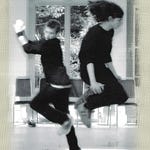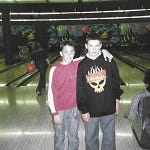In a video recently posted on YouTube, John Darnielle discovers an old lyric sheet for an unreleased song named ‘New Suit’ tucked into a copy of Sophocles, an author he was studying at Scripps College, in his hometown of Claremont, where he was approaching the end of a double major in English and Classics around 1993-4.1 Demonstrating the unfinished tune for viewers interested in his composition process, he launches into the first line (‘Smoke rises up from distant fires’) over a restrained, muted strum – then stops. ‘That’s how it would be if it was the Mountain Goats now,’ the singer chuckles wryly, before considering a rather different proposition: ‘What would this have sounded like when it was written?’
The answer is a sudden welter of sound, as if the person producing it has been jammed into a generator with some of the cables still loose. Darnielle hammers out a series of rapid, ringing open chords, and hurls himself into a melody so strident it makes him screw his eyes up; the veins begin to bulge in his neck. This is, perhaps, the archetypal image of the band’s boombox era, though delivered by a performer tapping into a version of himself from nearly three decades earlier: a passionate young man bristling with energy and dedicated to making as much noise as possible.
The source of that noise is an instrument Darnielle hadn’t initially even realised could be played that way: having set his cap early on against a certain kind of stereotypically Californian confessionalism, the acoustic guitar originally struck him as a ‘soft’ instrument not well-suited to the ‘hard-rocking’ preferences of a player who was already a serious thrash fan. But as he told Acoustic Guitar Magazine, in a sentence whose brevity belies its intensity, ‘after a week alone in a room with it, all my preconceptions … fell away.’
Though I doubt he’s ever really embraced the imprecise ‘folk-punk’ tag, the tension between its terms speaks to what stands out in an acoustic context about Darnielle’s most indicative strumming pattern, out in force on ‘New Suit’: an insistent DAHgadda-DAHgadda-DAHga which speeds up towards a rattling, rapid-fire conclusion. The intensity of this attack, even without more intricate melodic work, might call to mind the aesthetics of metal, unamplified — it reminds me of nothing so much as the brittle ferocity of the Wedding Present, down to the closing freakout where it feels as if the instrument assaulted like this might simply fall apart in the guitarist’s hands.
The voice over the top shares something with the frothing frustration of David Gedge, especially on tenser compositions like the later ‘Baboon,’ but with more agility and a gung-ho, ‘in-for-a-penny’ attitude to sustaining notes. One listen, for instance, to ‘Going to Wisconsin’ or ‘Going to Chino,’ on both of which John throws himself around the melody like an exuberant child on a climbing frame, supports Sasha Frere-Jones’s contention that Darnielle ‘may be the least self-conscious singer alive.’ And perhaps here is a good place to note that something which has always impressed me about the Mountain Goats is the self-belief necessary to release recordings like this into the world, to push on through your own limitations and trust that people will still find something in the work that speaks to them.
Growing up as a kid with dodgy fine motor skills, prone to weird noises and awkward movements, there was something inherently liberating about discovering a singer who seemed not to give a fuck if he didn’t look or sound ‘normal,’ who was comfortable enough to own his imperfections, who had found a way to channel all the messiness and fallibility of the body into a compelling, convulsive energy onstage. In a Catholic context, we might link all of this to the operations of grace: the idea that human endeavour is always falling short (or flat) but that our inevitable flaws are not beyond forgiveness. Watching John fuck a note up, cackle through it and grin, has taught me more than any mental health influencer about the possibility of rejecting shame.
Around ’93 – in which Darnielle asserts he had the most ‘bonkers-productive summer’ of his writing life to date – to ’96, the cells in the ‘Songs released this year’ column on my master spreadsheet for this project start to expand like accordions. So on a practical level, it’s hard to see how he could have found the time to make each recording note-perfect – which was never the point. John has described the white heat of his early process: ‘read until something jumps out at me’ (or watch horror movies, or TV psychologists, with the sound down); ‘play guitar and ad-lib out loud until I get a phrase I like; write the lyrics, get the song together, record immediately.’ The shape of songs emerged in the wake of these improvisations, often over reasonably traditional chord patterns, ‘with an intense focus, usually in one sitting.’2
Darnielle has spoken in more recent interviews about the necessary ‘sculpting’ process of revision after ‘the initial creative spark,’ but over the years sections of the fan base have undeniably fetishised the relative rawness of these early releases. Transmissions to Horace isa set of nine original songs, and one Commodores cover, ‘written and recorded over the course of one week’ during the 1992 Christmas holidays. Its opening number, ‘Going to Cleveland,’ ‘has attracted a small group of listeners who adhere to the very hard line that it's the absolute high water mark of the Mountain Goats. May God bless their souls,’ as John writes in the liner notes to a compilation reissuing much of this material, 2002’s Bitter Melon Farm.3
‘Going to Cleveland’ is certainly representative of some key facets of the boombox era. It takes the form of a break-up conversation between two lovers who seem to always be talking past each other:
You say you wanted to strike first
Because one of us was leaving, that’s what you say
But I've always been real fond of you
So I never would have treated you this way
While the relationships between the parties aren’t always clear, this framework of miscommunication recurs across the year’s bumper crop of songs: ‘You said the soil looked nitrogen poor … But for myself it looks kind of nitrogen rich’ (‘Sun Song’); ‘I hear you talking / Shut up’ (‘The Hot Garden Stomp’); and a passage from ‘Going to Monaco’ worth quoting in full:
The sea gobbles up the full sun, and I
I look at you and I know you’re the one
The one I used to know something about
And I try to say what it was, but the words won’t come out
And you ask me to hold you
That’s the devil’s work
I’d be remiss not to mention the Alpha Couple here, to whom at least six Mountain Goats songs had been dedicated by this point: there are few more succinct distillations of the feeling that the person you love has started to feel like an unreachable stranger than the chorus of the second of these to see daylight, ‘Alpha Double Negative: Going to Catalina’:
And I know what you’re saying
And I know what you’re saying it for
But I’m not listening
I’m not listening anymore
Darnielle’s interest in these kinds of dynamics arises partly from the ‘common reality’ of divorce in Southern California, including, of course, his own parents, who separated when he was five years old. But ‘Going to Cleveland’ explicitly, if playfully, sets itself against a biographical reading: ‘And you say, “Hey, John, where are you going” / But that’s not my name anymore.’ This is one of many ways in which the early tapes don’t represent a linear starting point which leads to the later work. Fans who came onboard in the 4AD era might expect these tapes to be packed wall-to-wall with fraught evocations of doomed relationships on a bed of basic cowboy chords, but the contents are more experimental than that. Taking that term as I’ve come to apply it on the MA module on experimental writing which I taught over the past few months, ‘experimental’ can mean nothing more or less cerebral than ‘trying stuff out.’
The fabled ‘first song’ ‘Going to Alaska’ hums with Hawaiian slide, and incorporates elements of sound collage; ‘Pure Milk’ features the synthetic drum loops and floating tones of the Casio SA-7 keyboard; I’ve got frankly no idea how ‘Two Thousand Seasons’ was recorded, but it sounds like a tentative lullaby intended to soothe a temperamental teleportation unit.4 A testament to Darnielle’s eclecticism, this flurry of experiments is also a natural enough thing to pursue in a small-scale tape-trading culture when you don’t expect your work to need to perform consistency for a wider listenership. His rate of productivity here, even alongside his studying commitments, might simply be an indication of a writer coming to view his own craft as labour – ‘is it asking that much of a dude to write a song a week?’ and himself as one of what Leonard Cohen called the ‘workers in song.’ But even as their author evades biographical content, it’s hard to ignore the fact that the mid-twenty-something writing these songs has repeatedly told interviewers he didn’t expect to make it past his twenty-first birthday, having moreover spent a lot of time ‘assuming I would die by my own hand.’ I don’t think I’m being overly sentimental in wondering if hyper-productivity is a natural consequence of feeling that a new lease on life has been handed to you – an unforeseen and precious opportunity for ‘hauling these songs to the light from the mouth of the grave.’
In 1993 I was looking elsewhere for my doses of sublime intensity, but you could say that I was also animated with the energy of resurrection. Tractors were over, and their shock-jock misuse on ‘Pure Milk’ had nothing to do with it5: I was getting into dinosaurs.
As for many kids, I think the appeal was at least partly the sense of scale involved: the size of the great stomping animals themselves, of course, but also the way their existence and extinction necessitate discussion of a kind of deep time, stretching so far beyond what any three-year-old child has ever experienced as to be ‘unimaginable, unimaginable.’ Family legend has it that I learned to read by picking out their long, complicated Latin names from looking at dinosaur magazines over my grandma’s shoulder, and whether or not that’s true, for me they’ve always been deeply linked with language and the imagination. When I came to edit an anthology of dinosaur poems for children in 2019, in an introduction that also functioned partly as an elegy for the woman who first brought their world to life for me, here’s what I wrote: ‘because no one alive today has ever seen a dinosaur, everything we know about them is the result of people making up stories.’ And here’s the story I made up about them for myself:
I think dinosaurs are a great subject for poetry because they make us think about what another world was like: our own Earth, but very long ago, before anything like humans was even a glint in the cosmic eye … Saying all those difficult names, when all the animals you’ve seen in real life are called things like ‘pig’ and ‘dog’ and ‘duck’, is almost like using a magic summoning spell.
I never became a palaeontologist, like I wanted to do when I was a little boy … But I did become a writer, and I think dinosaurs had a lot to do with it. No one in my family had been to university before me, but reading about dinosaurs made me curious and interested in knowing about things, to the point where my Nan used to call me The Professor — which is now my job.
My grandma, Joyce Junkin, died a year before the anthology came out. To the best of my knowledge, she never heard a Mountain Goats song, and I don’t know what she would have made of it if she had. But it was important to me, in that introduction and in all I do, to be ‘a witness to her life and to its worth.’ Nan was a keen gardener, and she nourished me and my developing interests as much as any plant. John, meanwhile, around the same time, drew the cover to Hot Garden Stomp on the porch of his nonagenarian grandmother, Umbra’s house while she slept.
I don’t know what the plant on it is supposed to be, if it’s even real – it has a certain eldritch character. But I imagine it needs the same things to flourish as we all do, from the smallest lithops to the largest Jurassic tree fern: a trinity Darnielle spells out at the very end of the boombox era – a little water, a little bit of sunlight, and a little bit of tender mercy.
Pitzer College was his main institution, with Classics classes held extramurally at Scripps.
For more on this process, including my attempts to reconstruct it ‘from the inside,’ look out for posts on our Instagram @thirty_years_later.
Other than that sweet Cuyahoga glow, I’m not sure there’s any particular reason this narrator has chosen this location to escape his problems: but on the other hand, ‘we’d all like to flee to the Cleve.’
From the Screamin’ Jay Hawkins reference alone, it’s clear that there’s also strong blues influence on Darnielle’s writing in this period: witness the high chord voicings of ‘Beach House,’ the repetitive structures of ‘Don’t Take the Dogs Away,’ and the widespread tendency to add tension by sliding in and out of 7ths and suspensions.
Though imagine my delight on discovering a Darnielle interview which features a bunch of toy John Deeres impressive enough to make the farmers of Colo, Iowa, ‘shift in their chairs’ at a local auction.
This week, Richard is getting into thirty first-year poetry assignments which he has to mark before Monday, so see you on the other side.
















1993: 'Going to Cleveland'